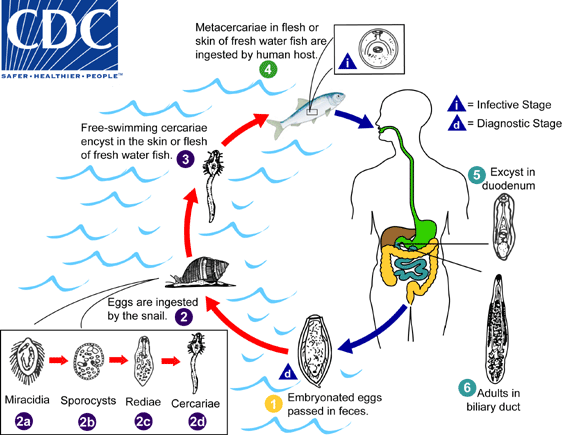Biology
Causal Agent:
The trematode Clonorchis sinensis (Chinese or oriental liver fluke).
Life Cycle:

Embryonated eggs are discharged in the biliary ducts and in the stool ![]() . Eggs are ingested by a suitable snail intermediate host
. Eggs are ingested by a suitable snail intermediate host ![]() . Each egg releases a miracidia
. Each egg releases a miracidia ![]() , which go through several developmental stages (sporocysts
, which go through several developmental stages (sporocysts ![]() , rediae
, rediae ![]() , and cercariae
, and cercariae ![]() ). The cercariae are released from the snail and after a short period of free-swimming time in water, they come in contact and penetrate the flesh of freshwater fish, where they encyst as metacercariae
). The cercariae are released from the snail and after a short period of free-swimming time in water, they come in contact and penetrate the flesh of freshwater fish, where they encyst as metacercariae ![]() . Infection of humans occurs by ingestion of undercooked, salted, pickled, or smoked freshwater fish
. Infection of humans occurs by ingestion of undercooked, salted, pickled, or smoked freshwater fish ![]() . After ingestion, the metacercariae excyst in the duodenum
. After ingestion, the metacercariae excyst in the duodenum ![]() and ascend the biliary tract through the ampulla of Vater
and ascend the biliary tract through the ampulla of Vater ![]() . Maturation takes approximately 1 month. The adult flukes (measuring 10 to 25 mm by 3 to 5 mm) reside in small and medium sized biliary ducts. In addition to humans, carnivorous animals can serve as reservoir hosts.
. Maturation takes approximately 1 month. The adult flukes (measuring 10 to 25 mm by 3 to 5 mm) reside in small and medium sized biliary ducts. In addition to humans, carnivorous animals can serve as reservoir hosts.
Life cycle image and information courtesy of DPDx.
- Page last reviewed: March 17, 2015
- Page last updated: March 17, 2015
- Content source:


 ShareCompartir
ShareCompartir